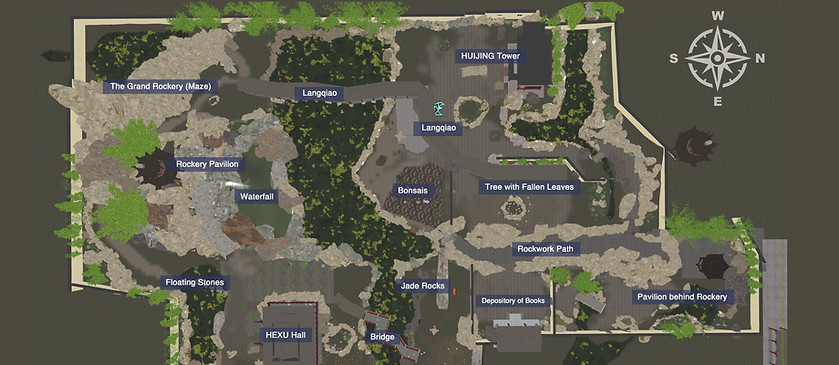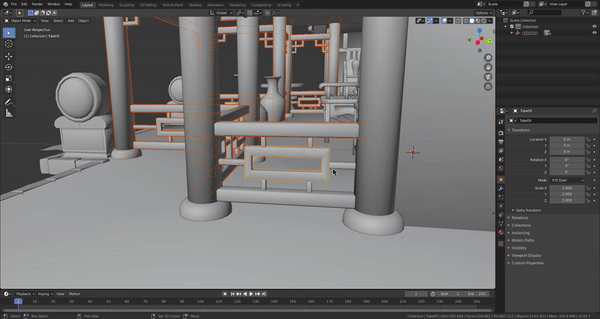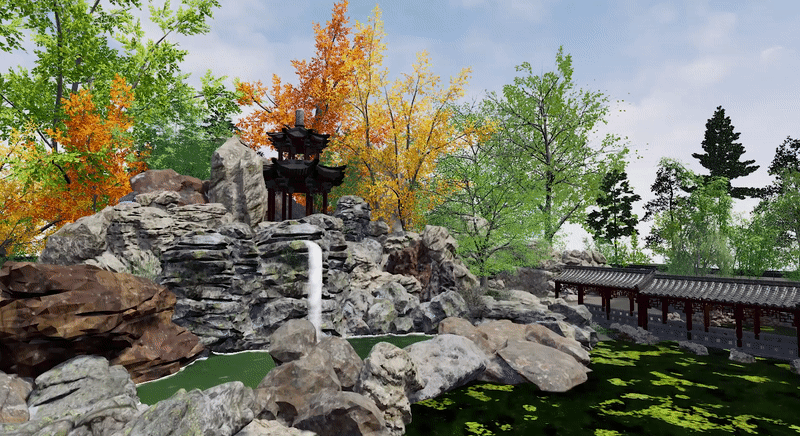VR Experience for PC
[ Individual Project ]
Game Overview:
Chinese Garden design emphasizes creating a space that marries nature and humanity. Its philosophy has quite a lot of influence on some of the modern spatial designs such as modern western gardens, parks, and other venues. It might have influenced contemporary Disneyland landscape design in some way as well.
When I was watching a talk from Joe Rohde, a former Imagineer, he mentioned that the “The notion of one step, one picture: the cinematic nature of Chinese garden design compels you to stop and consider, and then stop and consider again.” Growing up in China, I always knew about this notion of “one step, one picture” that exists within the gardens. Knowing the potential connection between Chinese Garden designs and contemporary Disneyland design, I became more interested in this idea of “one step, one picture”. Therefore, I made this VR experience and try to demonstrate this ideology.
This is an authentic VR experience in which the player can roam within a Chinese Garden and live the idea of “one step, one picture”. Each step they take will offer them a unique yet beautiful scenic view.
This project is made in two weeks, and it works both as personal research into Chinese Garden design, as well as a fast learn & practice over the basics of being an environmental artist, level design in 3D, as well as some technical art.

Purpose of the Project:
1. Authenticity and the “One step, one picture” of Chinese Garden.
2. To create a VR experience using UE4 on my own within two weeks.
Project Purpose 1: Authenticity & the "One Step, One Picture"
Since this is going to be a virtual experience, the Chinese garden must be as authentic as possible. This means that it is going to include various traditional Chinese elements as well as symbols. Other than the authenticity, as mentioned above, the idea of "one step, one picture" is fairly important in the philosophy of Chinese Garden design. Every time when a player stops and look around, there should be a scene. This project needs to fit both requirements. And I planned to kick the project off with various research.
1. Research and fieldtrip to local garden.



Before the fieldtrip, I read three books related to Chinese Garden Design:
The Chinese Garden History, Art & Architecture by Maggie Keswick (Left)
On Chinese Garden by Congzhou Chen (Middle)
Group Essays on Chinese Garden by Congzhou Chen (Right)


Fieldtrip to local garden: the Yu Garden, first built in 1559 during the Ming Dynasty by Pan Yunduan as a comfort for his father.
The garden consists of various areas and it is the perfect reference for this project. I live close to it so I was able to visit it multiple times throughout the process of making this project. Every time I visit it, I bring back inspiration and ideas on how to modify my garden for better authenticity and views.
2. Creating the garden as researched.
When creating the garden, I followed strictly with what I have researched because this is the way to achieve true authenticity as well as the idea of "one step, one picture". Below are some examples.
Early map draft and important elements:

In this very draft map I made in the early stage, I drew listed some of the specific elements required in my garden:
1. Various pavilions
2. Architectures
3. Body of water
4. Giant trees
5. Langqiao (Covered bridge)
6. Rockery (not listed but drawn on the map).
These are some of the most common elements included within any given Chinese garden.
Rock by the walls:

REALITY
REALITY

IN-GAME
During the research and field trip, I realized that there is no clear ending of any artificial wall, meaning that the guest will not be able to see the vertical side of the "white wall". The wall always ends with a rockery. symbolizing the seamless transition between nature and humanity.
Opening holes for view in rockery maze:

REALITY

IN-GAME
Within the rockery maze, there are many artificial/natural holes or cracks on the rocks to "reveal" the outside scenery to guests who are located within the rockery. The picture shown above is a hole located above the guests' heads. When the guests look up, they will see the beautiful tree branches. I created a similar opening hole/crack within my rockery maze for the player to raise their head to see.
The Langqiao (covered Bridge):

REALITY

IN-GAME
The Langqiao is a pretty important part of a Chinese garden. It is a covered bridge across the water (and some land) which offers a good view as well as practical uses such as rain protection. From the picture on the left, the Langqiao in Yu Garden uses rocks as base support underneath the main body of the bridge. Therefore, I mimicked that in my garden.

IN GAME (EARLY VERSION)

REALITY
When I finished the early version of Langqiao, I felt strange waking within it. Therefore, I went back to my book and found out that I made a mistake having the Langqiao totally straight. In the book On Chinese Gardens by 陈从周 (Congzhou Chen), he noted: "园林中曲与直是相对的,要曲中寓直,灵活应用,曲直自如。" This translates to: "In Chinese gardens the winding and the straight are relative in sense. The winding exists within the straight and vice versa. They should appear to co-exist naturally and complement each other." The straight should coexist naturally with the winded but in my scene, the straight is too artificial, tuned down the nature aspect of the bridge. After that, I then revisited the Yu Garden, and took pictures as a reference for the on-bridge view (top right).

IN GAME (MODIFIED)

IN GAME (MODIFIED)
3. Achieving "one step, one picture":
In order to achieve "one step, one picture", I constantly visit back to my research materials, and every time when I take a look, I would be inspired and wanted to add more details to the map. I would often pan my camera around at any given angle to see if I can add details to adjust and modify any given scene. Here are some in-game screenshots that demonstrate some of the views.



Project Purpose 2: To create a VR experience on my own in two weeks.
This project works both as research into the Chinese Garden design as well as a personal practice on UE4 skills such as environmental design, level design, as well as some basics of technical arts such as gameplay optimization. Within the two weeks of making this project, I have quickly picked up the fundamental skills of finding appropriate assets, assigning materials, making assets on my own using Blender, as well as game performance optimization such as the use of LOD.
I gave myself two weeks for this particular project because I know that during the first year of ETC at Carnegie Mellon University, there will be grouped virtual world-building sessions each takes around two weeks to complete. Because this is the ideal program that I am aiming at, I want to challenge myself and see if I am able to make a playable experience in VR using two weeks as a time cap. In this way, I can better equip myself for the upcoming challenges.
1. Finding assets and assigning materials:

ONLINE ASSET

PROCESS ASSET
I was able to find various 3D assets online for free but the majority of them were only 3D models without any materials. So I went into Blender and separated the asset into different sections so I can color them differenty in UE4. I then found the right materials and created material instances from a master material so that the material-assign process becomes much faster for the entire project.

MASTER MATERIAL

MATERIAL ASSIGNED
2. Creating unique assets for the garden:


Some of the assets I want to include, such as the moon walls above are very unique and I was not able to find ready-made ones to use. Therefore, I picked up Blender and made those assets on my own. I also created the Bonsai Holder (bottom left) as well as the transparent wall (bottom right) that reveals scenes.


3. Optimizing game performance through LOD:
Because there were many assets within this scene, I was experiencing a huge framerate issue. Putting the VR headset on was a horrible experience. Therefore, I looked into ways of enhancing the performance. One of the tools is the use of LOD levels. I also chopped off a large portion of triangles of certain objects such as some of the trees as well as bonsais so that I can reduce unnecessary processing power. Overall, the current version performs a lot better, but there is still room for improvement.

Feedback:
When I present this work to my friends and have them test it, they all mentioned that this game makes them quite dizzy. This feedback is totally expected because I also felt uncomfortable while playing it. This might have something do to with my movement system (smooth movement instead of teleporting), the still-low framerate, as well as some level of screen-tear. The frame rate can be easily solved if I have a better way of optimization, or I can simply run the application on a better laptop/desktop. As for screen-tear and minor glitches, I am not sure if I can fix it for now, so I'd have to look into it in the near future.
Reflections:
This experience is really a walking simulator. I am quite satisfied with the fact that I was able to complete it within two weeks, but I admit that there are many improvements needed for this project. One of the most obvious one is the optimization of the performance because it is making people sick when they play this game (as mentioned in the feedback). There are many ways to fix this issues. When I have more time, I would love to play with Culling Distance, merging actors, and other various ways for optimization.
Another feature I want to add into this project would be some level of interactivity, whether it is adding a simple mission in which the player have to obtain certain objects, or an interactive experience in which that they player can freely write up their own poems when they face certain sceneries (which is what ancient people do when they come to Chinese Gardens.)
This version of a Chinese Garden is very immature, still. Chinese Garden as a subject takes years or even lifetime to learn and (maybe) master. I am glad that I started my first step of learning this with the help of UE4, and I am excited to revisit this subject in the near future after I visit more gardens around China, as well as other places in the world. I will be making more Chinese Gardens.

